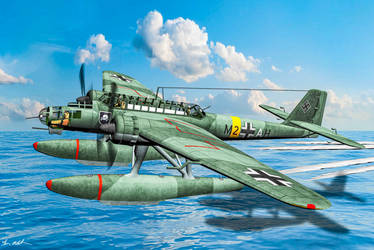ShopDreamUp AI ArtDreamUp
Deviation Actions
Description
E-boats (German: Schnellboot, or S-Boot, meaning "fast boat") was the designation for fast attack craft of the Kriegsmarine during World War II. It is commonly held that the British used the term E for Enemy.
The S-boat was a very fast vessel, able to cruise at 40 or 50 knots, and its wooden hull meant it could cross magnetic minefields unharmed. It was better suited to the open sea and had substantially longer range (approximately 700 nautical miles) than the American PT boat and the British Motor Torpedo Boat (MTB). As a result, the Royal Navy later developed better matched versions of MTBs using the Fairmile 'D' hull design.
As a result of the Treaty of Versailles, Germany's military production was severely curtailed. However, small patrol craft were not subject to any strictures. S-boats can trace their lineage back to a private motor yacht—a 22-ton-displacement, 34-knot craft called Oheka II, which had been built by the German shipbuilding company Lürssen in 1927 for a wealthy financier and patron of the arts, Otto Kahn.
This design was chosen because the theatre of operations of such boats was expected to be the North Sea, English Channel and the Western Approaches. The requirement for good performance in rough seas dictated the use of a round-bottomed displacement hull rather than the flat-bottomed planing hull that was more usual for small, high-speed boats. Lürssen overcame many of the disadvantages of such a hull and, with the Oheka II, produced a craft that was fast, strong and seaworthy. This attracted the interest of the German Navy, which in 1929 ordered a similar boat but fitted with two torpedo tubes. This became the S-1, and was the basis for all subsequent S-boats.
After experimenting with the S-1, the Germans made several improvements to the design. Small rudders added on either side of the main rudder could be angled outboard to 30 degrees, creating at high speed what's known as the Lürssen Effect.[3] This drew in an "air pocket slightly behind the three propellers, increasing their efficiency, reducing the stern wave and keeping the boat at a nearly horizontal attitude".[4] This was an important innovation as the horizontal attitude lifted the stern somewhat, allowing even greater speed, and the reduced stern wave made S-boats harder to see, especially at night.
More at:[link]
The S-boat was a very fast vessel, able to cruise at 40 or 50 knots, and its wooden hull meant it could cross magnetic minefields unharmed. It was better suited to the open sea and had substantially longer range (approximately 700 nautical miles) than the American PT boat and the British Motor Torpedo Boat (MTB). As a result, the Royal Navy later developed better matched versions of MTBs using the Fairmile 'D' hull design.
As a result of the Treaty of Versailles, Germany's military production was severely curtailed. However, small patrol craft were not subject to any strictures. S-boats can trace their lineage back to a private motor yacht—a 22-ton-displacement, 34-knot craft called Oheka II, which had been built by the German shipbuilding company Lürssen in 1927 for a wealthy financier and patron of the arts, Otto Kahn.
This design was chosen because the theatre of operations of such boats was expected to be the North Sea, English Channel and the Western Approaches. The requirement for good performance in rough seas dictated the use of a round-bottomed displacement hull rather than the flat-bottomed planing hull that was more usual for small, high-speed boats. Lürssen overcame many of the disadvantages of such a hull and, with the Oheka II, produced a craft that was fast, strong and seaworthy. This attracted the interest of the German Navy, which in 1929 ordered a similar boat but fitted with two torpedo tubes. This became the S-1, and was the basis for all subsequent S-boats.
After experimenting with the S-1, the Germans made several improvements to the design. Small rudders added on either side of the main rudder could be angled outboard to 30 degrees, creating at high speed what's known as the Lürssen Effect.[3] This drew in an "air pocket slightly behind the three propellers, increasing their efficiency, reducing the stern wave and keeping the boat at a nearly horizontal attitude".[4] This was an important innovation as the horizontal attitude lifted the stern somewhat, allowing even greater speed, and the reduced stern wave made S-boats harder to see, especially at night.
More at:[link]
Image size
1366x768px 429.49 KB
© 2012 - 2024 melkorius
Comments5
Join the community to add your comment. Already a deviant? Log In
The notch cut in the bow for torpedo clearance seems a better idea than PT boat launch methods.


































